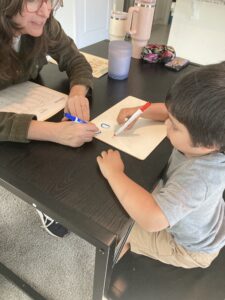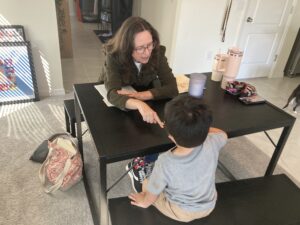I employ a Structured Linguistic Literacy approach to teaching reading. I have training in Reading Simplified, developed by Dr. Marnie Ginsberg. I incorporate many Reading Simplified activities into my lessons; however, I am not affiliated with Reading Simplified. Streamlined Reading Instruction | Reading Simplified

ASSESSMENT
After discussing with the parent to understand their reasons for seeking tutoring and their goals for the student, I will administer a few informal assessments. These assessments will help me identify the student’s most pressing needs and determine the appropriate pathway to begin their reading journey. Each pathway aims to help students achieve fluency in reading at their grade level or higher.
THE THREE-PART READING LESSON
Once I identify the appropriate pathway to follow, we can begin with the three-part lesson. I will select specific activities tailored to address your child’s most pressing needs
THE FIRST PART: RE-READ FOR FLUENCY
The first part of the three-part lesson is called “Re-read for Fluency.” During this segment, the student will reread the passage that was introduced in the previous session. The primary benefits of this repeated reading routine include improved word identification, increased reading fluency, enhanced decoding skills, boosted student confidence, and better reading comprehension
THE SECOND PART: WORD WORK
The second part of the lesson is known as “Word Work.” I will choose two activities from the options: Switch-it, Read-it, Write-it, or Sort-it.
Switch-it is a fun and engaging game that children enjoy, often without realizing they are learning important skills related to the alphabetic principle, letter-sound knowledge, phonemic segmentation, phonemic manipulation, and early decoding and spelling abilities. I believe it serves as the heartbeat of our tutoring sessions, providing a powerful opportunity for accelerated and advanced learning.
Read-it is a whiteboard activity in which I teach students how to blend. Reading Simplified uses an approach they call Blend as You Read. Some people call it continuous blending. I call it POWERFUL!
It is a simple technique of teaching students to sound out the first two sounds of a word and continue to say the sound as they add the next sound. It is easier to understand if you see it done.
Write- it boosts the skills of spelling, reading, and writing. It uses the strategy of Write and Say. It is another simple, but powerful strategy in which students say the sounds of the word as they write it. Find out more about Write-it here.
Sort-it is for students who are ready for advanced phonics, which is sooner than you think. Once they can blend 3 and 4 sound short vowel words they are ready for advanced phonics, which includes long vowel combinations, diphthongs, and vowel digraphs. Reading Simplified teaches by sorting by sound, not spelling. For instance, in one lesson introduce the long vowel “o” and its major spellings (i.e., “o,” “o_e,” “ow,” “oa,” “oe”). It is amazing how this approach works so well, that even kindergarteners understand it. Find out more about Sort-it here.
THE THIRD PART: GUIDED READING

The last part of the three-part lesson is called Guided Reading. I like to think of it as a new read. The student will be reading a new text that matches the level that they are on on the pathway. This is the time that they learn or practice the blend as you read strategy. I will also buddy read on the harder words and gradually decrease the amount of the support I provide during future tutoring sessions. This is also a time to develop comprehension skills by having they develop a brief summary. Find out more about Reading Simplified Guided Reading here.
BONUS HANDWRITING ACTIVITY
There is also a bonus handwriting activity that I use as needed. I follow the Peterson Handwriting prompts that I learned about here. I find that these prompts decrease the cognitive load during handwriting instruction and all students that I have taught have improved their fluency and accuracy in handwriting.
BONUS PHONICS GAMES
I also use card games or board games that coincide with the different levels of the pathways. We will typically play a game if there is time at the end of the session and sometimes I will assign them as part of their homework.
HOW LONG DOES IT TAKE TO COMPLETE A PATHWAY?
It typically takes about 12 hours to complete a pathway and students usually increase at least a grade level. It is not uncommon for the lessons to benefit students in additional areas that have to do with processing information. It seems to be more effective if the sessions are done twice a week and if students complete homework.
Ready to get started?
Want to go deeper with how this process works? Visit this page: How Are These Lessons Different